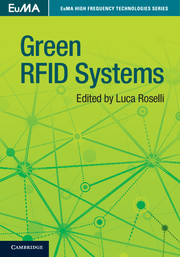Book contents
- Frontmatter
- Contents
- List of contributors
- Introduction
- 1 Context analysis
- 2 RFID background
- 3 Energy scavenging and storage for RFID systems
- 4 Technologies for RFID sensors and sensor tags
- 5 Unconventional RFID systems
- 6 Integrating tiny RFID- and NFC-based sensors with the Internet
- 7 Materials for substrates
- 8 Organic conductors and semiconductors: recent achievements and modeling
- 9 RFID enabling new solutions
- 10 Energy-efficient off-body communication using textile antennas
- Index
- References
7 - Materials for substrates
Published online by Cambridge University Press: 05 October 2014
- Frontmatter
- Contents
- List of contributors
- Introduction
- 1 Context analysis
- 2 RFID background
- 3 Energy scavenging and storage for RFID systems
- 4 Technologies for RFID sensors and sensor tags
- 5 Unconventional RFID systems
- 6 Integrating tiny RFID- and NFC-based sensors with the Internet
- 7 Materials for substrates
- 8 Organic conductors and semiconductors: recent achievements and modeling
- 9 RFID enabling new solutions
- 10 Energy-efficient off-body communication using textile antennas
- Index
- References
Summary
Introduction
Selecting proper materials for substrates depending on applications is one of the most important design steps in the field of microwave designs because substrate material determines relative dielectric constant (εr), loss (tan δ), and flexibility. The impedance of transmission lines such as microstrip lines and co-planar waveguides (CPW) is a function of the relative dielectric constant (εr) and thickness of the substrate as well as its physical dimensions. Therefore, the dimensions of transmission lines, like width of conductors or gap, are decided by the substrate material. For compact system integration, a substrate which has high relative dielectric constant (εr) is preferable since it increases capacitances of the overall microwave circuit components, resulting in small feature sizes and low radiation losses. Otherwise, a material with low relative dielectric constant (εr) is a good substrate for structures for radiation like antennas or RFIDs. The thickness of the substrate is also an important design parameter. It is directly related to effective relative dielectric constant (εeff), which has effects on resonance frequency as well as on feature sizes of the structures on the substrate. It is obvious that the resonance frequencies or poles of RF components like antennas or filters change depending on effective relative dielectric constant (εeff), which is a function of substrate thickness. In addition, directivity of antennas is affected by the thickness of the substrate because the radiated wave tends to propagate to a material with high dielectric constant (εr), which results in an uneven radiation pattern as the substrate thickness increases. The loss of the substrate should be considered when the substrate is chosen too. The loss of the substrate may limit microwave circuit designs since some designs are not compatible with high loss substrates like a cavity filler or an antenna which has high-Q factor. The loss of the substrate can be reduced by utilizing a thin substrate but sometimes it may also be acting as a fabrication limitation for stability of fabrication reasons. For flexibility, the thickness and the natural properties of the substrate material are critical. Flexible substrates are preferred for use in certain applications, such as biomedical. The material and the thickness should be carefully chosen based on application requirements.
- Type
- Chapter
- Information
- Green RFID Systems , pp. 176 - 194Publisher: Cambridge University PressPrint publication year: 2014



